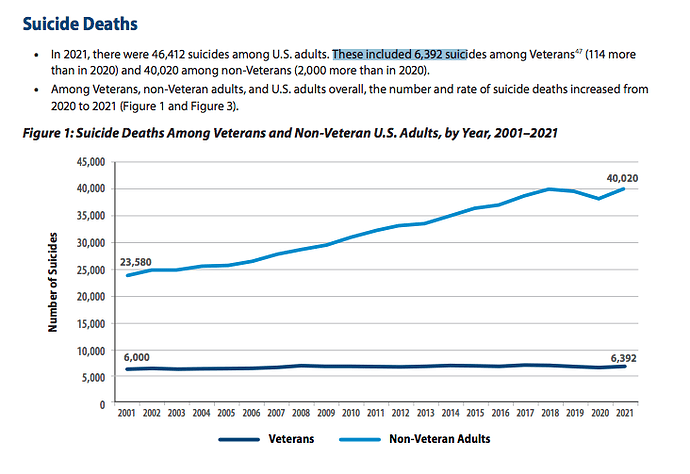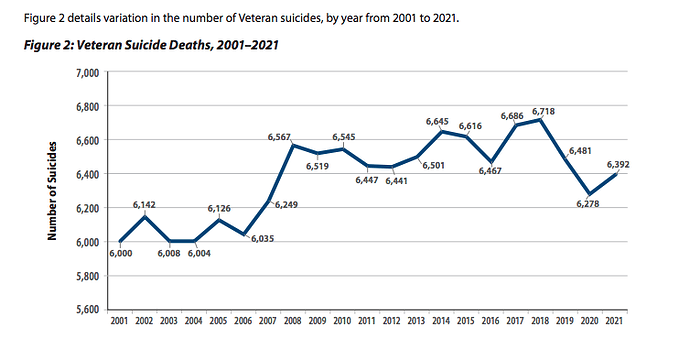“The best way to drive out the devil, if he will not yield to texts of scripture, is to jeer and flout him, for he cannot bear scorn."
—Martin Luther
THE DATA
From 2001 to 2021, the 69.7% increase in suicide deaths among non-veterans in the United States was 969% greater, or eleven times greater than the 6.5% increase among veterans during the same time period.
That’s because, in the military, they don’t let you stay on your phone all day long.
(Veteran vs. non-veteran suicides in the United States, 2001 to 2021)
It’s not like the thesis is complicated or obscure.
In 2023, a study published in the journal Preventive Medicine found that there is a clear correlation between screen time and suicidality among young people, and that each additional hour of daily screen time was associated with a 9% increase in suicidal behavior.
From 2001 to 2021, the 90.4% increase in suicide among female veterans was 103.6% greater, or more than twice as great as the 43.6% increase among their male peers.
More than twice as many women in the military kill themselves than men because geomagnetic storms are accompanied by an increase in female psychotic depression and non-psychotic depression mental health admissions, but not among males.
And the number of women who use their phones more than 6 hours a day is 100% greater, or double that of men who did the same.
From 2001 to 2021, suicide among female Veterans without recent Veterans Health Administration use increased by 93.7%.
From 2001 to 2021, suicide among female Veterans increased by an average of 90.4%, or nearly doubled.
From 2001 to 2021, suicide among female Veterans with recent Veterans Health Administration use increased by 87.1%.
From 2001 to 2021, suicides deaths among non-veteran adults in the United States increased by 69.7%, from 23,580 to 40,020.
From 2001 to 2021, suicide among male Veterans without recent Veterans Health Administration use increased by 62.6%.
From 2001 to 2021, suicide among male Veterans increased by an average of 43.6%.
From 2001 to 2021, suicide among male Veterans with recent Veterans Health Administration use increased by 24.5%.
From 2001 to 2021, suicide deaths among veterans in the United States increased by 6.5%, from 6,000 to 6,392.
From 2001 to 2018, suicide deaths among veterans in the United States increased by 12%, from 6,000 to an all-time high 6,718.
From 2001 to 2018, suicide deaths among veterans in the United States increased by an annual average of .7%.
From 2008 to 2020, veteran suicide deaths in the United States decreased by 4.4%, from 6,567 to 6,278.
From 2008 to 2020, veteran suicide deaths in the United States decreased by an annual average of .4%.
In 2008, there were 6,567 veteran suicide deaths in the United States.
From 2016 to 2018, veteran suicides in the United States increased by 3.9%, from 6,467 to 6,718.
From 2016 to 2018, the 2% average annual increase in suicides among veterans in the United States was 187.5% greater, or almost three times greater than their .7% average annual increase from 2001 to 2018.
Here, from 2016 to 2018, we see the grim peak of technology-driven suicides among veterans in the United States.
From 2016 to 2018, the suicide rate among veterans in the United States increased by an annual average of 2%.
In 2016, there were 6,467 veteran suicide deaths in the United States.
From 2018 to 2020, the 3.3% average annual decrease in veteran suicide deaths in the United States was 725% greater, or more than eight times greater than their .4% average annual decrease from 2008 to 2020.
In 2018, the great positive societal change began increasing hyper-exponentially, going forward in time.
That’s because the health of the ether is inexorably increasing, and moral and mental health vary directly with that of the subject’s etheric environment.
From 2018 to 2020, veteran suicide deaths in the United States decreased by 6.6%, from an all-time high 6,718 to 6,278.
From 2018 to 2020, veteran suicide deaths in the United States decreased by an annual average of 3.3%.
From 2008 to 2020, veteran suicide deaths in the United States decreased by an annual average of .4%.
From 2018 to 2019, veteran suicide deaths in the United States decreased by 3.5%, from an all-time high 6,718 to 6,481.
In 2018, there were an all-time high 6,718 veteran suicides in the United States.
(Veteran suicide deaths, 2001 to 2021)
From 2018 to 2020, the 14.1% decrease in the suicide rate among women Veterans in the United States was 67.8% greater than the 8.4% decrease in the suicide rate among women in the United States.
The suicide rate is decreasing at an exponentially greater rate among women in the military versus their civilian peers because women in the military are not allowed to be on their so-called “smart” phones all day long, as their civilian counterparts are.
From 2018 to 2020, the suicide rate among women Veterans decreased by 14.1%.
From 2018 to 2020, suicide among veterans decreased by 9.7%.
From 2018 to 2020, the suicide rate among women in the United States decreased by 8.4%.
Here, from 2018 to 2020, we see the inexorably-increasing health of the ether breaking the back of technology driven suicide in the United States.
From 2019 to 2020, suicide deaths among veterans in the United States decreased by 3.1%, from 6,481 to 6,278.
In 2020, there were 6,278 veteran suicide deaths in the United States.
In 2019, there were 6,481 veteran suicide deaths in the United States.
From 2020 to 2021, the 24.9% decrease in suicide among veteran women aged 55 to 74 years was 4,050% greater than the .6% decrease among veteran men the same age.
What’s the variable? I believe it has to be that the numbers among women had previously increased so much farther above those of males.
From 2020 to 2021, the 8.1% decrease in suicide among Veteran men aged 75 and older was 1,250% greater than its .6% decrease among Veteran men aged 55 to 75 years.
What’s the variable? Lower technology use among male Veterans aged 75 and older versus their technology-addicted 55-to-74 year old peers.
From 2020 to 2021, suicide among Veteran women aged 55 to 74 years decreased by 24.9%.
From 2020 to 2021, suicide among Veteran men aged 75 and older decreased by 8.1%.
From 2020 to 2021, suicide among Veteran men aged 55 to 74 years old decreased by .6%.
In 2020, there were 6,278 veteran suicide deaths in the United States.
In 2021, the 36.3 per 100,00 suicide rate among white veterans was 108% greater, or more than double the rate of 17.4 per 100,000 among black veterans.
White veterans kill themselves twice as often as black veterans because schizophrenia, or demonic possession as it used to be plainspokenly known in the old days, is an inherited condition of the distinct and separate species of human which we know as Homo neanderthalensis.
The Devil literally made them do it, or a devil, at any rate.
THE ARTICLES
SEPTEMBER 2022
On September 19, 2022, va.gov said “VA releases report showing decrease in Veteran Suicides, names suicide prevention grantees and finalists”.
Where the uncredited author said “decrease” because it is general.
As a propagandist, they knows that seventy percent of readers only read the headlines, and that their hedging generality goes a long way toward “compartmentalizing” awareness of the speed and scope of the decrease in suicide which they are attempting to obfuscate.
That’s an example of the propaganda technique known as “compartmentalization”.
For those unaware, anytime an author is uncredited, it is proof that said author is an Intelligence operative.
The uncredited Intelligence operative from the State propaganda organ known as va.gov said “reporting showing decrease” to give the subconscious of the Coincidence theorist reader the green light to say “oh, but they can make those reports show anything!” or “oh, but that was just one report!” or “oh, someone must have reported that incorrectly!”
As a propagandist, they know that many or most readers will grasp virtually any straw, no matter how thin, to remain off the hook of personal responsibility.
The article goes on to say “Today, the Department of Veterans Affairs released the 2022 National Veteran Suicide Prevention Annual Report, which shows that Veteran suicides decreased in 2020 for the second year in a row, and that fewer Veterans died by suicide in 2020 than in any year since 2006.”
In a world where 70% of readers only read the headlines, another large percentage only read the first paragraph. Thus, the general “suicides decreased” and “fewer Veterans died by suicide” go a long way toward “compartmentalizing” awareness of the speed and scope of the decrease in suicide which they are attempting to obfuscate.
That’s an example of the propaganda technique known as “compartmentalization”.
Then the uncredited Intelligence operative from the State propaganda organ known as va.gov spewed four fat paragraphs of chaff, and, in journalistic parlance, “buried” this below them:
"Key findings from ‘the 2022 National Veteran Suicide Prevention Annual Report’* include:
In 2019 and 2020, Veteran suicides decreased in consecutive years by 307 and 343 deaths — the biggest decrease in the suicide count and rate since 2001.
From 2018 to 2020, the age- and sex-adjusted suicide rate among Veterans fell by 9.7%
Among women Veterans, the age-adjusted suicide rate fell by 14.1%, compared to 8.4% among non-Veteran women. The age-adjusted suicide rate for women Veterans in 2020 was the lowest since 2013, and the age-adjusted suicide rate for Veteran men was the lowest since 2016.
From 2019 to 2020, Veteran suicide rates fell across all racial groups."
The propagandist omitted the data from 2019 to 2019 and from 2019 to 2020, and, in journalistic parlance, “buried” it in the starred link above.
That is an example of the propaganda technique known as “compartmentalization”.
They repeated the meme “fell” three times in a row because it is a thinly-veiled reference to the fallen Lord Lucifer.

(The fall of Lucifer, from “Paradise Lost”, by John Milton, 1667)
From 2018 to 2020, the 14.1% decrease in the suicide rate among women Veterans in the United States was 67.8% greater than the 8.4% decrease in the suicide rate among women in the United States.
The suicide rate is decreasing at an exponentially greater rate among women in the military because those women in the military are not allowed to be on their so-called “smart” phones all day long, as their civilian counterparts are.
From 2018 to 2020, the suicide rate among women Veterans decreased by 14.1%.
From 2018 to 2020, suicide among veterans decreased by 9.7%.
From 2018 to 2020, the suicide rate among women in the United States decreased by 8.4%.
In the report, we learn:
"From 2020 to 2021:
• Suicide rates fell by 8.1% for Veteran men aged 75-years-old and older.
• Among Recent Veteran Veterans Health Administration (VHA) Users between ages 55- and 74-years-old, the suicide rate fell by 2.2% overall (-0.6% for men, -24.9% for women).
• Among male Recent Veteran VHA Users, suicide rates fell by 1.9% for those aged 18- to 34-years-old"
They repeated the meme “fell” three times in a row because it is a thinly-veiled reference to the fallen Lord Lucifer.

(The Fall of the Rebel Angels, by Pieter Brueger the Elder, the Netherlands, 1562)
From 2020 to 2021, the 24.9% decrease in suicide among veteran women aged 55 to 74 years was 4,050% greater than the .6% decrease among veteran men the same age.
What’s the variable?
From 2020 to 2021, the 8.1% decrease in suicide among Veteran men aged 75 and older was 1,250% greater than its .6% decrease among Veteran men aged 55 to 75 years.
What’s the variable? Lower technology use among those aged 75 and older.
From 2020 to 2021, suicide among Veteran women aged 55 to 74 years decreased by 24.9%.
From 2020 to 2021, suicide among Veteran men aged 75 and older decreased by 8.1%.
From 2020 to 2021, suicide among Veteran men aged 55 to 74 years old decreased by .6%.
The study goes on to say “From 2001 to 2021: Recent Veteran VHA Users rates grew more slowly across 20 years when compared to rates of Veterans without Recent VHA use. From 2001 to 2021, age-adjusted suicide rates rose 24.5% for male Veterans with Recent VHA use and 62.6% for male Veterans without Recent VHA use. Age-adjusted suicide rates rose 87.1% for female Veterans with recent VHA use and 93.7% for female Veterans without Recent VHA use.”
The study goes on to say:
“In 2021, the unadjusted suicide rate was 46.3 per 100,000 for American Indian or Alaska Native Veterans; 36.3 per 100,000 for White Veterans; 31.6 per 100,000 for Asian, Native Hawaiian or Pacific Islander Veterans; 17.4 per 100,000 for Black or African American Veterans; and 6.7 per 100,000 for Veterans of multiple races.”
Jeff Miller, Honolulu, HI, June 13, 2024
If you’d like to be added to this free mailing list, please send me a note at [email protected].

